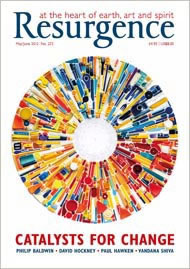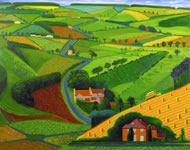We have to be grateful to David Hockney for bringing Nature into the heart of London; his landscape paintings, which were exhibited earlier this year at the Royal Academy, are a reminder to city people that ultimately it is the fields, forests, hills, rivers and the natural environment that are the true source of beauty, security, inspiration, livelihood, health and jobs.
When most people in London, especially politicians, business leaders and the media, are ever obsessed with money, finance, economic growth and higher living standards, it is the work of great artists like David Hockney that draws our attention to the real wealth, the natural capital, which we often take for granted.
Shelley once wrote: “Poets are the unacknowledged legislators of the world.” Hockney may not be a poet of words but he is certainly a poet of colours and images. He may be the best legislator of all, though he may not want to be. In my view – though again he may not want to be called such – he is the hero of the environmental movement; his work is a great celebration of Nature and our deep relationship with the Earth.
We needed the Hockney exhibition at a time when the environmental policies of the British government are in tatters. Before the election we were told by David Cameron to “vote blue and get green”, but one of the first things Cameron did after coming to power was to abolish the Sustainable Development Commission; after that, his government tried to push through privatisation of the precious forests of Britain. That was followed by a Conservative proposal to change the planning laws, giving priority to development over the environment.
If all that were not enough, Cameron’s much-vaunted ‘greenest government ever’ is now imposing a high-speed rail network on some of the greenest countryside of England and is proposing to build an airport in the Thames Estuary in Kent. On top of all that, the government also tried to reduce the Feed-In Tariffs for renewable energy (a move that was first declared illegal by the High Court, and then rejected by the Supreme Court).
George Osborne, the Chancellor of the Exchequer, appears to believe environmental policies are holding back economic development. In his view the environment and the economy have no connection with each other. But the truth of the matter is that the economy is a wholly owned subsidiary of the environment. Destroying the environment to save the economy is like cutting the branch upon which it is sitting. If his own chancellor is so ignorant of such basic facts, how can Cameron claim to be heading “the greenest government ever”?
There is another reason for which Hockney deserves our gratitude. The world of arts has become infected with the pseudo-art of conceptualism, where controversy is more important than creativity. Hockney’s work, some of which we have featured on page 50, is more than a passing fashion. Art, for Hockney, is a way of life. He believes that art requires commitment, dedication and hard work.
Hockney’s meditation on Nature is essentially a manifestation of the implicit harmony of life – where a profound love of Nature is married with the deep imagination to create the place where great art is born.
Hockney brings a breath of fresh air and restores our hope in the arts. After seeing the great exhibition of Hockney’s paintings at the Royal Academy, I can comfortably say that the arts are more than entertainment and more than commercial investment: they are a springboard for transformation in human consciousness, leading to social, spiritual and ecological transformation.








